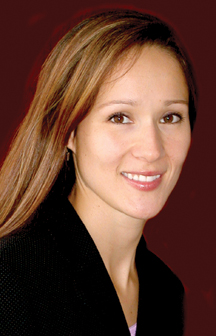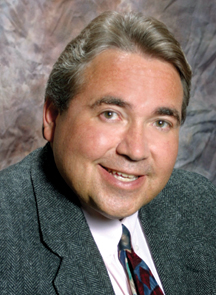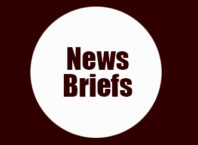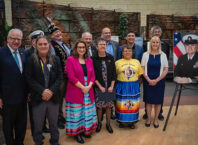
 Native Report, a weekly TV news magazine produced in Duluth, has been renewed for a fourth season and is scheduled to start in February. The program is produced for both Native and non-Native viewers and is offered for free to public television stations across the country.
Native Report, a weekly TV news magazine produced in Duluth, has been renewed for a fourth season and is scheduled to start in February. The program is produced for both Native and non-Native viewers and is offered for free to public television stations across the country.
Native Report, co-hosted by Stacey Thunder (Red Lake Ojibwe) and Tadd Johnson (Bois Forte Ojibwe), is an entertaining and informative TV news magazine that celebrates Native American culture and heritage, and discusses issues with some of the most influential leaders today.
Juli Kellner, Executive producer at WDSE-TV in Duluth, says story ideas come from people who call or send emails to Native Report. She, Thunder and Johnson then collaborate to make selections and put the shows together.As part of production, Thunder and Johnson each do their own writing as well as the reporting and interviewing.
Thunder says she is proud to be part of this ongoing effort to share
the stories of Native people. “The Native community has been
under-represented in popular media, and if there is coverage, it tends
to be negative,” Thunder said. “So Native Report shares the positive
and dispels the myths. Viewers get to know all of who we are.”
The fourth season will include programs that deal with topics such as:
American Indian children’s welfare; KILI Radio in Porcupine, SD;
Superintendent Dr. Page Baker of Badlands National Park; Native
American natural foods; National Congress of American Indians’
President Joe Garcia; country singer Crystal Shawanda; and many more.
The hosts say that Native Report chooses to focus on the positive news
throughout Indian Country, even when it covers the challenges. The
program takes a particular interest in efforts to deal with tough
issues. “We want to examine what folks are doing that works, what
approaches are proving themselves in areas like language
revitalization, economic development, and other issues. We want to
share what the elders are saying,” said Kellner.
The program grew out of an increasing concern with the pervasive
coverage of negative stories. “The idea for the show came from both the
WDSE Community Advisory Board and Tadd,” Kellner said. “It was his
brainchild, as a response to all the stories about drug abuse and
violence in Native communities. The majority of reporting was only
covering negative events, which are relevant but not always
representative of everything that is happening.”
Thunder became involved in the program when Johnson asked her to host
the shows. They were colleagues and lawyers for the Mille Lacs Band of
Ojibwe at the time. “It was his dream to have a show like Native
Report,” Thunder said.
The station put together a pilot series in 2004 with four short
episodes. After evaluating them, they made some changes to the format
and put out a full first season. Native Report’s season grew to 15
episodes by 2006.
Seasons One through Three include such stories as students learning the
Dakota language, tribal preparations for disasters and other threats,
the Rolling Plains Art Exhibit, raising buffalo, regional powwows, and
the new National Museum of the American Indian
An earlier story that means a lot to Thunder is her piece on the
recovery of walleye fish in Red Lake. In the 1990s, tribal leaders had
to make a difficult decision to close the lake to fishing due to a
collapse in the fish population. It was hard to shut people off from
their way of life and a resource they used to feed their families.
However, the tribe was able to cooperate with the Minnesota Department
of Natural Resources and reopen the lake much earlier than the planned
ten-year moratorium because the fish population grew so fast. Thunder
values the story as an example of the important and inspirational
accomplishments in the Native community.
Thunder previous positions included working with the Anishinabe Legal
Services, the Indian Child Welfare Law Center, and as a tribal attorney
for the Red Lake Band, and corporate attorney for the Mille Lacs Band
of Ojibwe Indians. She received a B.A. in psychology from Hamline
University and a J.D. in 1998 from William Mitchell College of Law. She
is a board member and Vice President for the Minnesota American Indian
Bar Association, and Vice President of Native Thunder Distance Runners,
an organization dedicated to promoting healthy lifestyles in the Native
American community.
Johnson is currently Solicitor General for the Mille Lacs Band of
Ojibwe where he works to protect the Band’s interests at the local,
state and federal levels. He also worked for five years with the U.S.
House of Representatives, ultimately becoming the staff director and
counsel for the House Subcommittee on Native American Affairs and in
1997, was appointed to chair the National Indian Gaming Commission by
then President Bill Clinton. He earned his bachelor’s degree from the
University of St. Thomas and his law degree from the University of
Minnesota
Native Report is aired from California and Alaska, to Florida and New
York. Many stations in the Midwest also carry the show. Each individual
station decides on the program’s slot in its local lineup, so viewers
should check their TV listings.
The current program is free to any interested public television station
and is funded by grants from the Shakopee Mdewakanton Sioux Community,
Mille Lacs Band of Ojibwe, Grotto Foundation, and Blandin Foundation.
The support from the Shakopee Mdewakanton Sioux Community allowed WDSE
to make the programs available in high definition for season four. It
is part of the shift to digital in 2009. “That was a great boost,”
Kellner said. “We are now ready for the digital transition.”
Response to the show has been supportive. The station often receives
emails congratulating them on its success. Thunder hopes Native Report
continues breaking stereotypes and allowing viewers to get to know
Native individuals and tribes for many seasons.
“Many people live next door to Native families and reservations but do
not know anything about them,” Thunder said. “Learning what Native
people are doing helps to shatter prejudice.”
In the Twin Cities metro are Native Report airs on TPT’s digital MN
channel, Sunday evening at 8:30 P.M. and on Monday mornings at 2:30 AM.
If you are interested in viewing Native Report in your area, contact
your local public television station and ask them to air it. If you
have story ideas, contact Native Report at 218-724-8567 or 888-563-9373.






